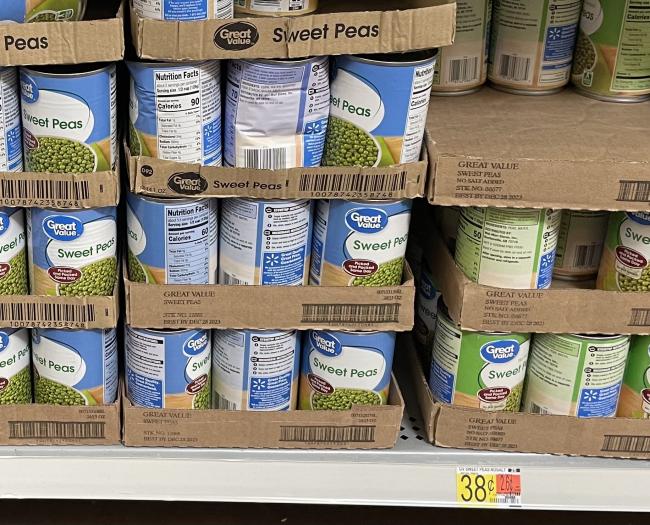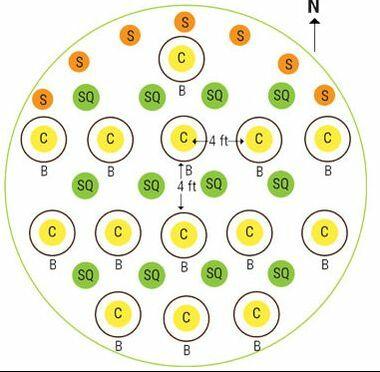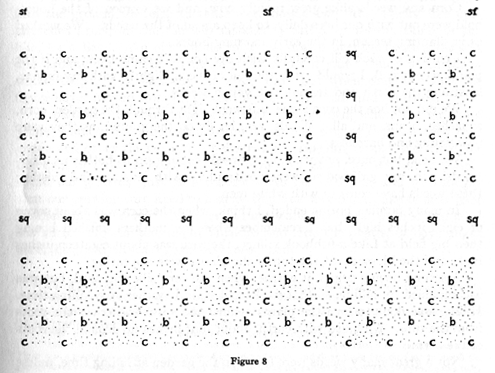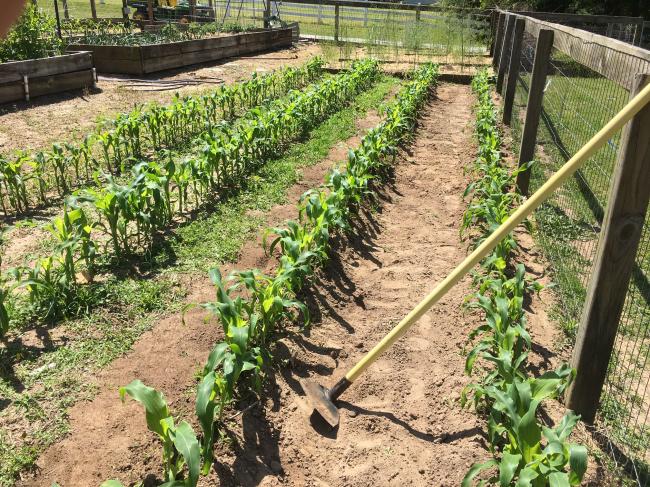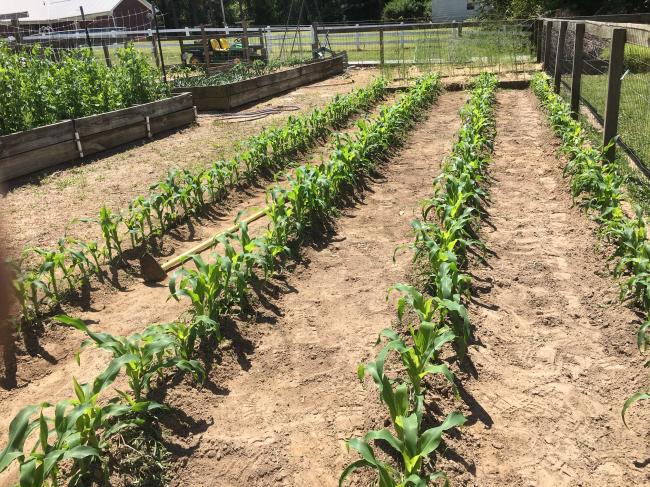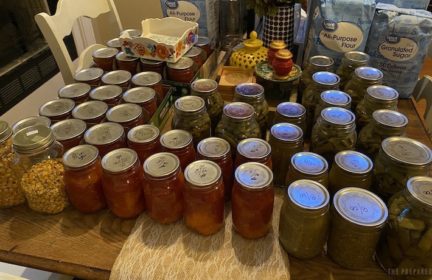Canning yourself or buying cans from the store – I found the cheaper option
I started prepping years ago. Dehydrated (freeze dried) #10 cans of food were reasonably inexpensive. Unbelievable the difference a year can make. I still buy #10 cans because today’s prices may seem cheap next year. But good deals are still available. Over the last month I’ve bought hundreds of small cans of vegetables (peas, corn, beans) for 38 cents at my Walmart. Actually both Walmarts in town have the same price. I’ve given my kids most of them. You can’t plant, grow, fertilize, and can for this price. By stocking up on these, I save time and my canning supplies for an emergency.
I took this picture 2 days ago.
-
Best Replies
Dog lover Dog lover - December 23, 2020
I never had a green thumb in life, but always felt that growing and preserving food was an important part of prepping. So several years ago I tilled up a garden area and planted some seeds. Needless to say the first year kind of sucked. But as I learned and added things to the soil I got better and better. It was not an overnight process though. The canning is fairly straightforward. I really recommend the Ball guide to canning. It will help keep you safe, especially in the beginning. The gear isn’t too expensive, but it is an investment initially. Now I have multiple canners, years worth of jars, lids and supplies. I still reference the Ball guide book some but am pretty good about keeping the process safe now. So, after this learning process I can say, and strongly recommend, that it is worth learning how to raise food and preserve it. None us us know how bad the economic affects will be from this pandemic. Being able to go to the grocery store is something we take for granted, but it may not always be an option. Having the resources and knowledge to continue taking care of yourself and the ones you care about is priceless, and worth the effort to learn these skills. I will say that if you thinking ‘I will learn to garden and plant some fruit trees when shtf,’ then you are likely to starve. It is a learning process, specific to your area, and takes a lot of effort to produce enough to last through the different seasons.
As far as right now, you can buy canned goods so much cheaper than growing and preserving that it is discouraging. There is no way I would sell a jar of my homegrown foods for less than 30$ a jar! Lol. The amount of work that goes into it just can’t compete with Walmart’s prices. Also, commercially canned foods last much longer than home canned goods. I never go past 2 years on home canned foods where the Walmart stuff can go many years. Remember, the expiration dates on cans is just suggested use by dates. They are still safe for much longer. I still prefer the taste of my gardens vegetables by far, and I control the amount of salt and lack of added chemicals. At one point I had more home canned goods than commercial cans. Now I run 3/4 commercially canned to my home canned stuff, just out of convenience. But knowing I have the ability and knowledge to replenish my pantry each year is a really good and secure feeling.
-
Comments (17)
-
Conrad B - December 13, 2020
I would like to have the knowledge on how to can, but I agree with you. With prices like that, and availability today, I would 100% stock up on cans like that!
Did you just notice that price? Or have you been keeping an eye on certain products for a price drop like that?
-
Winston Smith - December 13, 2020
I noticed it about a month ago. I’m not a canner, but I have all the equipment and the Ball Canning Book. I think I could figure it out when the time comes. Good luck.
-
-
Dog lover - December 23, 2020
I never had a green thumb in life, but always felt that growing and preserving food was an important part of prepping. So several years ago I tilled up a garden area and planted some seeds. Needless to say the first year kind of sucked. But as I learned and added things to the soil I got better and better. It was not an overnight process though. The canning is fairly straightforward. I really recommend the Ball guide to canning. It will help keep you safe, especially in the beginning. The gear isn’t too expensive, but it is an investment initially. Now I have multiple canners, years worth of jars, lids and supplies. I still reference the Ball guide book some but am pretty good about keeping the process safe now. So, after this learning process I can say, and strongly recommend, that it is worth learning how to raise food and preserve it. None us us know how bad the economic affects will be from this pandemic. Being able to go to the grocery store is something we take for granted, but it may not always be an option. Having the resources and knowledge to continue taking care of yourself and the ones you care about is priceless, and worth the effort to learn these skills. I will say that if you thinking ‘I will learn to garden and plant some fruit trees when shtf,’ then you are likely to starve. It is a learning process, specific to your area, and takes a lot of effort to produce enough to last through the different seasons.
As far as right now, you can buy canned goods so much cheaper than growing and preserving that it is discouraging. There is no way I would sell a jar of my homegrown foods for less than 30$ a jar! Lol. The amount of work that goes into it just can’t compete with Walmart’s prices. Also, commercially canned foods last much longer than home canned goods. I never go past 2 years on home canned foods where the Walmart stuff can go many years. Remember, the expiration dates on cans is just suggested use by dates. They are still safe for much longer. I still prefer the taste of my gardens vegetables by far, and I control the amount of salt and lack of added chemicals. At one point I had more home canned goods than commercial cans. Now I run 3/4 commercially canned to my home canned stuff, just out of convenience. But knowing I have the ability and knowledge to replenish my pantry each year is a really good and secure feeling.-
Gideon ParkerStaff - December 23, 2020
So well written! Thank you for the great comment.
I too have done a little gardening, and I believe that it is a skill that you can’t just pickup and get a bumper crop your first year. Lots of trial and error.
I hope I can learn how to can as well. It won’t be the most cost effective, nothing beats Walmart in price and shelf life like you said, but what happens when there is a famine and Walmart doesn’t have any? You will need to know how to grow and preserve your own like you said.
-
-
Dog lover - December 23, 2020
One thing I noticed from the original posts pictures is the dented can. Be aware that it may be safe to buy dented cans for immediate use, never store them. The risk of food poisoning is just too high. Botulism is odorless, colorless and is deadly. Always use anything dented first, and if your not sure if the contents being completely sealed, chunk it.
-
Winston Smith - December 31, 2020
Good point. I always inspect cans for dents and expiration dates. I know they last beyond that date, but I look for the longest date I can find.
-
-
RedneckContributor - December 23, 2020
You state, “You can’t plant, grow, fertilize, and can for this price.”
That is true but maybe misleading, because of the high cost of canning. I grow lots of vegetables but don’t can any of them. Only thing we can is fruits for jams & jellies. We generally eat our vegetables fresh and when we store them, they go into multiple freezers. Frozen veggies taste MUCH better than canned and can be stored much quicker. As far as the cost of growing them, there is not much expense at all. Take my Rattlesnake pole beans I grow. Each seed costs less than a penny each and will grow a vine 6+ feet tall. That one cent vine will produce lots of green beans for many months. I’d say during my growing season, maybe 2 plants would easily produce a can’s worth of beans. Being a legume that fixes nitrogen in the soil, they really don’t need fertilizer but if your soil needed some, that cost per plant would be minimal. My veggies will taste MUCH better than anything canned plus will be much healthier. Those canned veggies are full of all sorts of chemicals.
Granted, your canned veggies are designed to be stored for a few years but homesteaders that work toward self sufficiency can put up plenty of garden food into winter storage that does not need expensive & time consuming canning. Think of the three sisters for example. The native Americans did not can or freeze but flourished. Each of the three sisters could be eaten fresh but could also be dried naturally for winter storage. Living such a life would mean your diet would change throughout the year, depending on what was fresh or dried. Living such a life is sustainable.
I will not argue that you have found a good option for keeping food in storage. Having any food in storage is a great idea. I keep many thousands of pounds of food in long term storage, but the only canned items I keep is Spam… which I think can last forever if kept cool & dry. If I had to eat even one can of those canned peas in your picture, I would probably choose starvation. 🙂
IMO home canning is not a very reliable or cost efficient survival strategy for most people. To can enough of your home grown food to actually make a difference requires a huge expense that few are willing or able to handle. I have always believed that living as the native Americans did is the best and cheapest survival/prepper strategy
-
Gideon ParkerStaff - December 23, 2020
Growing up we would freeze our extra produce instead of canning. If you have the freezer space, this can be a great solution, and it takes so much less work and money.
I’m going to have to learn more about the three sisters when I get my own little house and garden. It sounds like a great strategy.
-
Dog lover - December 24, 2020
I have tried the three sisters a couple times. I found that none produced as well as when planted alone and got full sun. I guess with limited space it might work ok, and not needing a trellis for the beans is a plus. I have fencing around the gardens and usually rotate the running or climbing plants along them.
In all my gardening discoveries nothing compared to setting up a greenhouse. It tripled the production each year. Here in the south the sun will literally cook the plants mid summer, and storms don’t help either. I use a translucent woven nylon tarp for the roof and sides over a metal frame. I usually keep the sides open all summer now. But the semi protected area in it really does make an amazing difference compared to the outside garden area. The fabric I use is sourced locally from a farm supply. It is used primarily in chicken houses as dividing partitions. It costs just a little over 100$ For a 50×20’ tarp, and lasts about three years before the sun deteriorates it. The only drawback is it’s non porous. I have to water in there and don’t get the benefit of the rains. I need to find a less tightly woven material that will let rain drip through. -
RedneckContributor - December 24, 2020
I have learned from experience that a three sisters garden can’t be laid out like a normal garden of long narrow rows. I even tried increasing the spacing between my rows of corn and that didn’t help much either. The beans couldn’t get enough sun. The different tribes used different layouts but they all addressed the issue of getting sun to the plants. Generally it seems the best way to grow a three sisters garden is to have numerous small plots and it seems a circular plot is the most common. Now one might say that is not a very efficient way of building garden plots but remember, they did these by hand. A garden tractor does best when going straight but that is not an issue when doing the work by hand. Actually lots of smaller plots makes more sense when doing it by hand. Here are some examples of three sisters layouts. You will note in this image that there is a 4th variety planted on the north side of the plot. The “S” are sunflowers. This is a Wampanoag layout.
Below is a layout of a Hidatsa garden & it too has sunflowers growing to the north. They did so because sunflowers grow so tall and by keeping them on the north side of the garden, they could never shade the other plants. This comes from the book, Buffalo Bird Woman’s Garden, which is an absolutely fabulous instructional account of how the native Americans could grow & store so much without any modern conveniences.
Now one would really struggle making lots of these beds using crappy hoes you get at a hardware store. You need several of the really good ones. I use the Rogue 7″ field hoe. It is incredibly well made, very sharp & has a nice & heavy head on it. You might say, why do I want a heavy head? That weight at the very bottom is what makes the hoe indestructible and allows it to remove large amounts of grass/weeds easily. With a lightweight piece of junk hoe, all the chopping is done by your arms & back. With a heavy, sharp head, you basically just lift it on the upswing & let gravity do the rest. Once you try one, you will know what I mean.
https://roguehoe.com/field-hoe/
Me hoeing the corn this past spring.
-
Dog lover - December 24, 2020
Great post. I think the small plot idea for more sun and easier hand working makes a lot of sense
-
Winston Smith - December 31, 2020
Thanks very much for the informative post. I’m going to try the Wampanoag layout. I looked at the site for ordering the Rogue hoe, but there’s a delay in shipping due to the high volume of orders. Go figure. I heard the antique hoes are much better made than the newer ones.
-
Dog lover - December 23, 2020
One good thing about canning is once you have the jars and supplies there is very little expense after that. As long as you don’t break the jars they last for many years and are reusable over and over. The lids are really your only expense and are very cheap. Where the major costs come in is where I was counting the labor, both with growing and preserving. I own an electrical contracting business and can make a lot more money in a day than I could ever can in green beans. If we ever do have shtf then I imagine we will all have a lot more time at home for the gardening though. Regardless of the economics of gardening and canning though, it is incredible rewarding. The produce I can tastes so much better than any store bought products. I didn’t mean to sound negative on gardening, just pointing out that it’s much cheaper to buy stuff currently.
-
Winston Smith - December 31, 2020
Yep, and the used lids will work for dehydrated foods. Or, so I’m told.
-
Dog lover - December 31, 2020
I know some that will reuse the lids. They will seal again and are likely to be safe. Sure, in shtf I would reuse them, but in current times they are so cheap why would you risk both the produce you grew or getting food poisoning? I literally wiped out the Walmart shelf of canning lids two or three times in off seasons and have enough to last me the rest of my lifetime easily and didn’t have to invest a bunch of money. Most of my cases of jars were bought on sale in off season too. It’s a shame to think my son doesn’t have any desire to use the supplies I’ve collected over the years. Come to think of it though I hope he never has to need to use them in his lifetime. I see it as enough of a likelihood to want to be prepared though.
-
Gideon ParkerStaff - December 31, 2020
So you are the one that has been buying them all from Walmart!
Just kidding, but on a serious note, many people have been getting into canning this year and i’ve heard that canning supplies are harder to find. Glad you are able to still get some.
-
Dog lover - December 31, 2020
Lol. I was lucky enough to buy them a good while back before they became so popular. It seems many items we always took for granted have become scarce now.
-
-
- News for the Week 2025-12-15 - 1 day ago
- News for the Week 2025-12-08 - 1 week ago
- Building a ‘hospital bag’ - 2 weeks ago
- News for the Week 2025-12-01 - 2 weeks ago
- News for the Week 2025-11-24 - 3 weeks ago
This forum is heavily moderated to keep things valuable to as many people as possible. Full community policies are here. The basics:
- 1. Be nice to each other.
- 2. Stay focused on prepping.
- 3. Avoid politics, religion, and other arguments.
- 4. No unfounded conspiracies, fake news, etc.
- 5. Debate ideas, not people.
